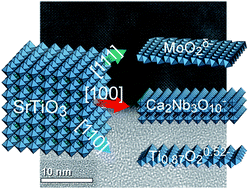Thin films are a part of everyday life; if you looked in a mirror today you experienced the advantages of a thin film at work. Crystalline thin films can be made of a range of functional materials and are essential to achieve the desired functionality of various devices including micromachines (not the miniature racing cars but micro-electronic-mechanical systems or MEMS). Crystal films can offer characteristics such as ferroelectricity and piezoelectricity, however these properties are strongly dependent on crystal orientation, degree of orientation and film crystallinity.
Epitaxial growth has become a highly important method for growing crystalline films as it allows for tailoring of properties in order to control electronic, optical and magnetic qualities. Unfortunately as described in this paper by Shibata et al, one of the basic requirements for attaining a good epitaxy is a close structural matching between a substrate and a growing crystal epilayer. This restriction causes a major obstacle for its wide application. In order to overcome this problem these researchers, led by Takayoshi Sasaki, have used 2D inorganic nanosheets of either Ca2Nb3O10–, Ti0.87O20.52- or MoO2δ- as highly organised layers depositied onto amorphous glass. These different surfaces allow for the deposition of SrTiO3 on to the glass with precise and selective control of crystallographic orientation.
This novel technique has already grabbed press attention because of its cost-effective and universal nature that comes from the possibility to use conventional substrates such as glass and plastic that wasn’t possible before. Whilst some development is still required this technique is already being seen as a huge leap forward in the growth of crystal films that will bring significant technological innovation in the future.
Tatsuo Shibata, Hikaru Takano, Yasuo Ebina, Dae Sung Kim, Tadashi C. Ozawa, Kosho Akatsuka, Tsuyoshi Ohnishi, Kazunori Takada, Toshihiro Kogure and Takayoshi Sasaki
J. Mater. Chem. C, 2014, 2, 441-449 C3TC31787K
H. L. Parker is a guest web writer for the Journal of Materials Chemistry blog. She currently works at the Green Chemistry Centre of Excellence, the University of York.
To keep up-to-date with all the latest research, sign-up to our RSS feed or Table of contents alert.











